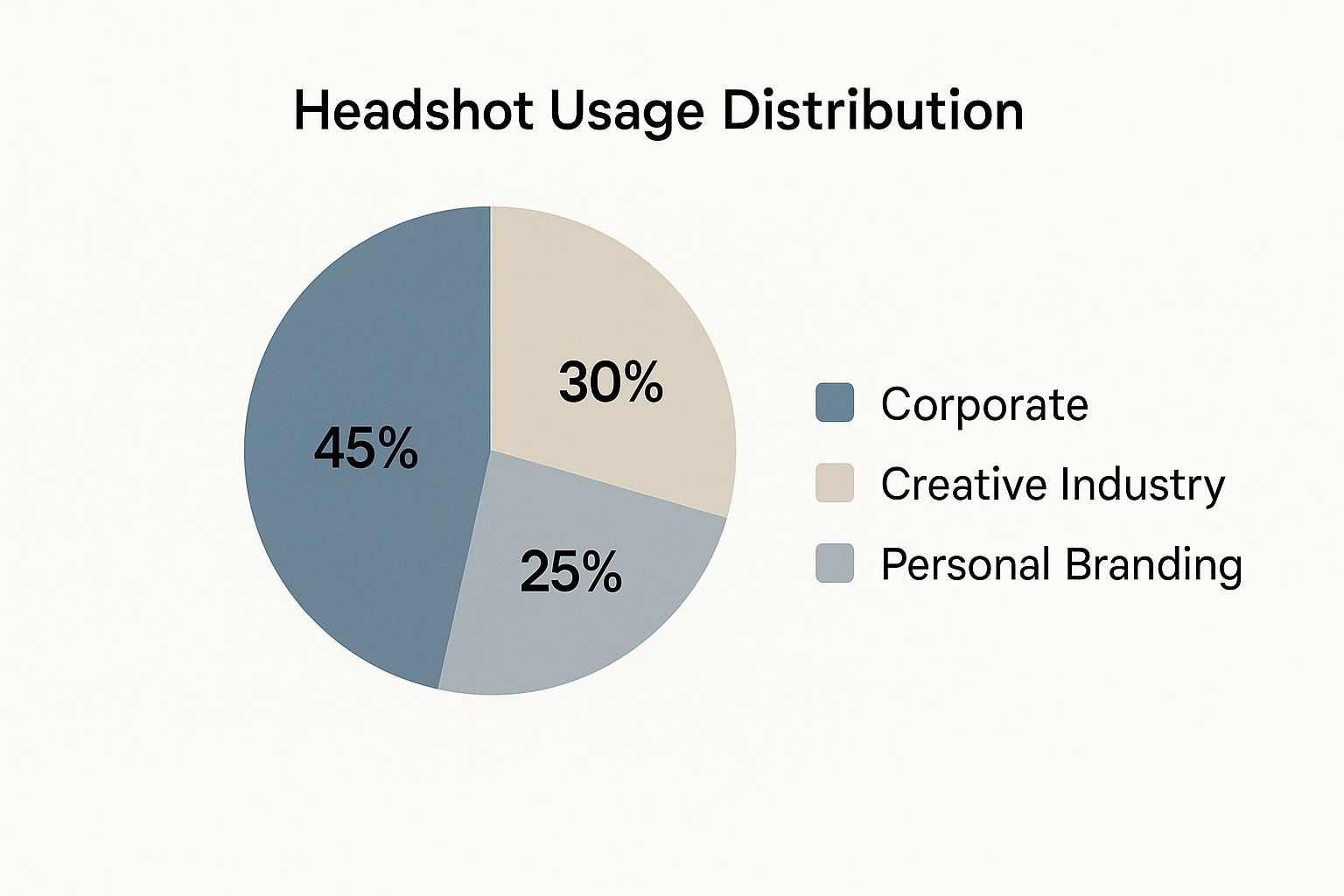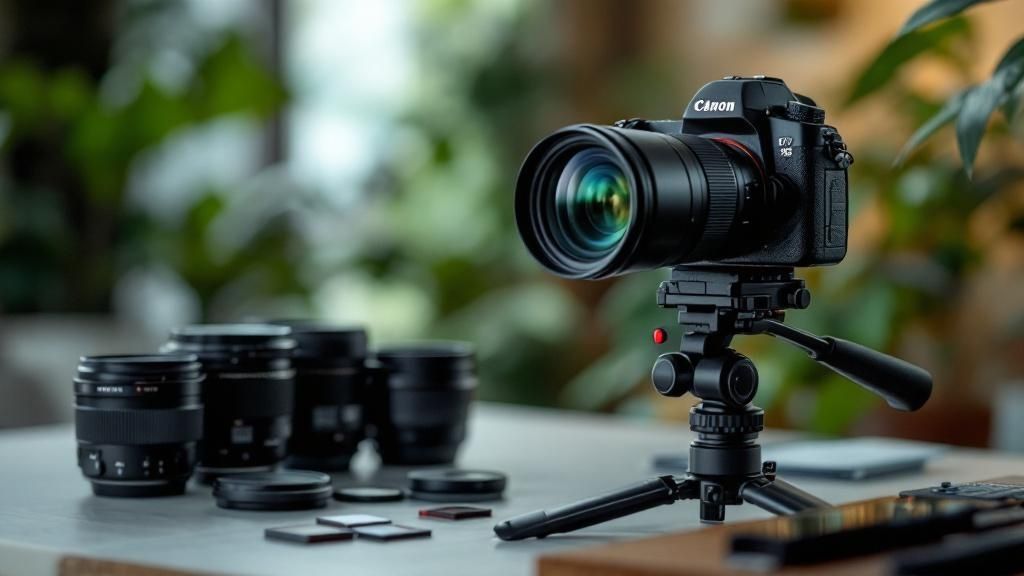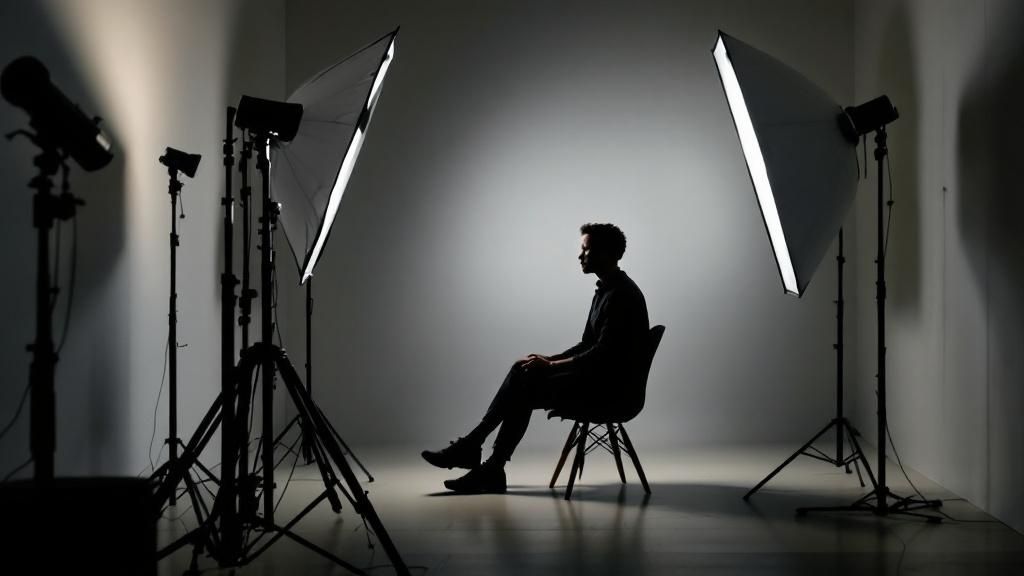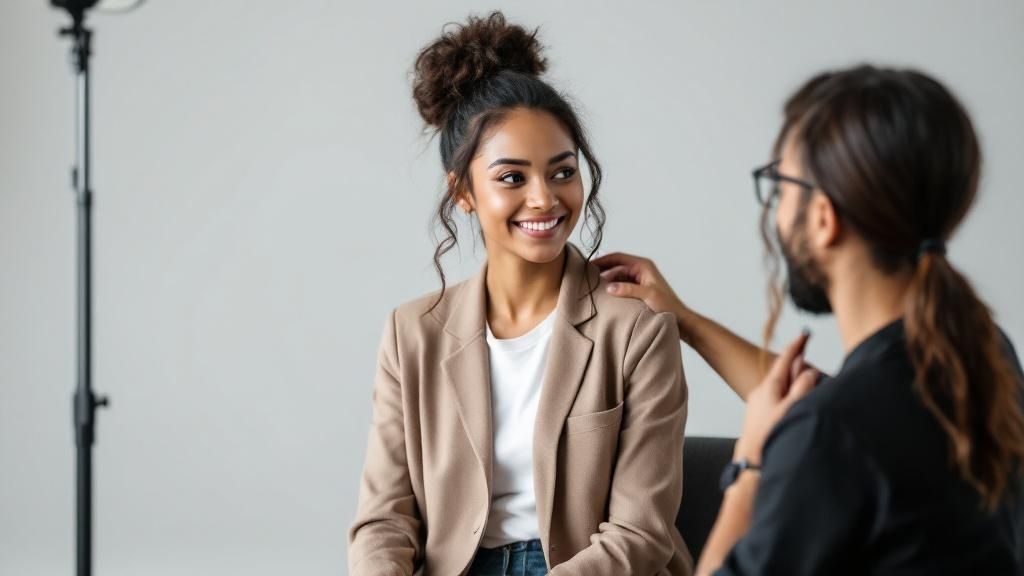How To Take Headshots: Professional Photography Guide
By Stephen on May 30, 2025
Essential Equipment That Actually Makes A Difference

This pie chart breaks down headshot usage across different categories: 45% corporate, 30% creative industry, and 25% personal branding. The dominance of corporate use underscores the importance of professional headshots in the business world. Understanding effective headshot techniques is crucial for anyone seeking to project a strong image, regardless of their field.
Camera and Lens: The Foundation of Your Headshots
The camera and lens combination is the core of headshot photography. While advanced cameras offer powerful features, even entry-level DSLR or mirrorless cameras can deliver excellent results with the right lens. Keeping track of online photography resources can be simplified through efficient bookmarking strategies, like those found on bookmarkify.io.
Lens Choice: A focal length between 50mm and 85mm is ideal for headshots, minimizing distortion and providing a flattering perspective.
Camera Body: Prioritize control over aperture, shutter speed, and ISO rather than the most expensive camera body.
Lighting: Setting the Mood and Tone
Lighting plays a transformative role in headshot photography, significantly impacting the mood and atmosphere of your images. Achieving professional results doesn't necessarily require expensive studio equipment.
Natural Light: Leverage natural light sources whenever possible. A large window serves as a beautiful, diffused light source for headshots.
Reflectors: Reflectors are an affordable and effective way to bounce light onto your subject, filling in shadows and creating a more even skin tone.
Diffusers: When shooting in direct sunlight, use a diffuser to soften the light and reduce harsh shadows.
Accessories: Enhancing Your Headshot Setup
While not strictly essential, some accessories can greatly enhance the quality and efficiency of your headshot sessions.
Tripod: A tripod guarantees sharp images, especially in low-light conditions. It also maintains consistent framing when capturing multiple shots.
Remote Shutter Release: Eliminate camera shake and enable self-portraits with a remote shutter release.
Backdrop: A simple, neutral backdrop helps create a clean and professional aesthetic.
Equipment Comparison: Budget Vs. Professional
To illustrate the various cost-effective options for headshot photography, we've compiled a comparison table. It demonstrates that you can achieve professional results without a significant financial investment.
Headshot Equipment Comparison: Essential equipment comparison showing budget vs professional options
| Equipment Type | Budget Option | Professional Option | Price Range (Approximate) |
|---|---|---|---|
| Camera | Entry-Level DSLR/Mirrorless | Full-Frame DSLR/Mirrorless | £500 - £2,000+ |
| Lens | 50mm f/1.8 | 85mm f/1.4 | £100 - £1,500+ |
| Lighting | Window Light/Reflector | Studio Strobes | £0 - £500+ |
| Backdrop | Plain Wall/Sheet | Collapsible Backdrop | £0 - £100+ |
This table clearly shows that achieving high-quality headshots is possible on a variety of budgets. By carefully selecting your equipment, you can prioritize the features that matter most for your work.
By understanding each piece of equipment's function and making informed decisions, you can create professional headshots that highlight your subject's best features. For guidance on wardrobe selection, explore this helpful resource on what to wear for professional headshots.
Mastering Light For Flattering Portraits Every Time

Lighting is key to capturing stunning headshots. Understanding how light interacts with your subject's face to create different moods and highlight their best features is essential. Fortunately, achieving professional results doesn't require expensive studio equipment. This section will guide you on using light effectively, whether you're using natural light or simple modifiers.
Understanding Fundamental Lighting Patterns
Professional photographers frequently use three primary lighting patterns: Rembrandt, butterfly, and split lighting. Each pattern creates a unique look suitable for various situations.
Rembrandt lighting, identified by a triangle of light on the cheek opposite the light source, adds depth and drama. This is particularly effective for a more serious or artistic headshot.
Butterfly lighting is created by positioning the light source directly above and in front of the subject. This produces a symmetrical, glamorous look, ideal for highlighting cheekbones and minimizing wrinkles, making it a popular choice for commercial or corporate headshots. Keep in mind, however, that this pattern might not suit everyone, especially those with prominent noses or high cheekbones.
Finally, split lighting illuminates only half the face, creating a moody, high-contrast image. Often used to add mystery or intrigue, this pattern can be very effective for creative professionals. Understanding these patterns and their applications can significantly elevate your headshot photography.
Making the Most of Natural Light
Natural light is a fantastic resource for headshots, especially when used effectively. A large window can provide soft, diffused light similar to a professional studio. Positioning your subject at different angles relative to the window will alter how the light falls on their face, offering diverse looks.
You can further enhance natural light with affordable tools. Reflectors bounce light back onto the subject, filling shadows and creating a more even skin tone. Diffusers soften harsh sunlight, minimizing glare and shadows. For a more in-depth understanding, check out this resource: How to Master Headshot Lighting Setups. Even at home, you can manipulate natural light to achieve professional results.
Managing Shadows and Maintaining Consistent Lighting
Shadows can either enhance or detract from a headshot. Harsh shadows can obscure features, while subtle shadows add depth and dimension. Controlling shadows is vital for professional-looking headshots. Techniques like using reflectors and diffusers, adjusting the light source position, and even incorporating shadows into the composition can significantly impact the final image.
Maintaining consistent lighting is especially important when photographing multiple people. This ensures a uniform look across all images, which is essential for team or corporate headshots. Whether using natural or artificial light, consistent light quality simplifies post-processing and contributes to a polished, professional portfolio. Positioning, lighting patterns, and diffusers play a role in achieving this consistency.
Utilizing Reflectors and Diffusers
Reflectors and diffusers are essential tools for headshot photographers. Reflectors come in various colours, each serving a distinct purpose. Silver reflectors create a cool, neutral bounce, while gold reflectors produce a warmer tone. White reflectors provide a softer fill light, ideal for reducing harsh shadows. A five-in-one reflector kit, containing multiple surfaces and a diffuser, is a valuable investment for versatile light modification.
Diffusers soften the light source, resulting in a more even distribution. This is especially useful in direct sunlight to eliminate harsh shadows and reduce contrast. Diffusers create a more flattering look in headshots by softening skin imperfections and reducing shine. By using reflectors and diffusers together, photographers can shape and control light, creating ideal lighting for any situation.
Choosing Locations That Enhance Your Subject

The backdrop for your headshot is much more than just background scenery; it's a powerful element that contributes to the overall narrative of the image. A thoughtfully selected location can transform an ordinary headshot into a compelling portrait that speaks to the subject's personality and profession. This section will explore the importance of location in headshot photography and offer guidance on choosing settings that complement your subject.
The Rise of Environmental Portraits
In the UK, headshot photography is shifting away from traditional studio setups and embracing the vibrancy of environmental portraits. This trend reflects a demand for more personalized and engaging imagery. Rather than relying on plain backdrops, environmental portraits utilize real-world locations to add context and depth to the image. The location itself becomes a key component of the visual story. This allows for increased creativity and the opportunity to showcase the subject's individuality.
This shift is evident in recent trends. In 2025, the preference for environmental portraits is particularly pronounced. Industry surveys indicate that roughly 70% of professional photographers in the UK have observed an increase in client requests for creative, location-based headshots since 2022. Explore this topic further.
Scouting the Perfect Setting
Choosing the appropriate setting is paramount for effective headshot photography. It's not simply about finding an aesthetically pleasing location, but about ensuring the environment aligns with the subject's brand and the intended message. A textured brick wall might be a fitting backdrop for a creative entrepreneur, while a corporate office setting might be more suitable for a business executive. Practical considerations such as accessibility, lighting, and necessary permissions should also be taken into account.
Practical Considerations for Location Scouting
Lighting: Carefully evaluate the natural light at various times of day. The golden hour, shortly after sunrise or before sunset, typically provides soft, flattering light. Overcast days also offer diffused, even lighting that can be ideal for portraits.
Background Elements: Seek out background elements that enhance the composition without distracting from the subject. Consider how textures, lines, and colors contribute to the overall visual appeal.
Logistical Concerns: Account for practical factors such as potential weather conditions, required permits, and ease of access to the location. Always have a backup plan in case of unforeseen circumstances.
Creating Clean Backdrops in Busy Environments
Even in bustling urban environments, opportunities exist to create clean, uncluttered backdrops. Employing a wide aperture (a low f-stop number) can effectively blur the background, isolating the subject and creating a sense of depth. This technique transforms a busy street into a soft, unobtrusive backdrop, shifting the focus to the individual. Strategic positioning and thoughtful framing can also help isolate specific areas within a complex environment to serve as a clean backdrop.
Conveying Professional Personas Through Settings
Different locations convey distinct professional messages. A library or bookshop can evoke intellect and sophistication, while a vibrant co-working space might suggest innovation and energy. For legal professionals, a courtroom or formal office setting reinforces authority and professionalism. By carefully considering the message conveyed by the environment, you can tailor the backdrop to strengthen the subject's professional image.
Directing Natural Expressions That Connect
Capturing a truly compelling headshot goes beyond technical skill. It requires drawing out genuine expressions that resonate with the viewer. This is where the art of direction comes into play. This section explores techniques for guiding subjects toward natural, engaging poses and expressions, regardless of their experience in front of the camera.
Guiding Poses for Effortless Confidence
Even experienced models can appear stiff with the wrong direction. The key is to encourage poses that feel natural and reflect the individual's personality. A slight shift in weight, a gentle turn of the shoulders, or a subtle head tilt can make a world of difference. When setting up your photography space, consider the subject's comfort and the overall environment. Resources on setting up an ergonomic workstation can be surprisingly helpful. These small adjustments can significantly improve posture and create a more relaxed, confident appearance.
Shoulder Position: Encourage a relaxed shoulder posture. Avoid a stiff, upright stance. A slight angle to the shoulders adds dynamism.
Head Tilt: Experiment with slight head tilts to find the most flattering angle for your subject's face. A gentle tilt can add a sense of engagement.
Hand Placement: Guide your subject on what to do with their hands. Options include lightly touching the face, placing hands in pockets, or holding a prop. Avoid stiff hand positions.
The Subtle Art of Directing Expressions
A genuine smile can transform a headshot. However, forced smiles often appear strained. The goal is to elicit authentic expressions. This can be achieved through conversation, humor, and a relaxed atmosphere.
Conversation Starters: Engage your subject in conversation to help them relax. Ask about their interests and professional goals.
Humor and Lightheartedness: Injecting humor into the shoot can ease tension and elicit genuine smiles.
Variety of Expressions: Encourage a range of expressions, from approachable smiles to more serious looks, depending on the desired tone. For inspiration, consider looking at examples of headshots.
Working with Camera-Shy Individuals
Many people feel uncomfortable being photographed. For camera-shy individuals, building rapport is crucial.
Positive Reinforcement: Offer encouragement and positive feedback throughout the shoot to boost confidence.
Mirroring and Matching: Subtly mirroring your subject's body language can create a sense of connection.
Breaks and Pacing: Allow for breaks during longer sessions to prevent fatigue. A relaxed subject projects a more natural image.
Avoiding Common Posing Mistakes
Certain posing mistakes can detract from the final image.
Over-Posing: Avoid overly contrived poses. Simplicity is key.
Ignoring Body Language: Pay attention to your subject's body language and adjust poses as needed to ensure comfort.
Inconsistent Energy: Maintain energy and enthusiasm throughout the session to keep your subject engaged.
By mastering these directing techniques, you can capture headshots that reflect the unique personality of each individual. This personal touch elevates the headshot from a simple portrait to a powerful branding tool.
Camera Settings For Consistently Sharp Results

Professional headshots depend heavily on understanding your camera settings. This knowledge ensures consistently sharp, well-exposed images, no matter the location. This section explores the best settings for capturing stunning headshots, covering everything from aperture and shutter speed to ISO and focusing.
Aperture: Controlling Depth of Field
Aperture, indicated by the f-number (e.g., f/2.8, f/5.6), governs the amount of light entering the lens and affects the depth of field. Headshots require a balance: a sharp subject and a softly blurred background.
Wide Aperture (Low f-number): Settings like f/2.8 or f/4 create a shallow depth of field. This blurs the background, highlighting the subject. It's ideal for isolating the individual for a professional look.
Narrow Aperture (High f-number): Settings like f/8 or f/11 increase depth of field, bringing more of the background into focus. This is useful for environmental portraits where the background adds context.
Shutter Speed: Eliminating Camera Shake
Shutter speed determines how long the camera's sensor is exposed to light. It's essential for avoiding blurry images from camera shake, particularly in low light.
Fast Shutter Speed: 1/250th of a second or faster is generally recommended for headshots. This freezes motion and minimizes camera shake, especially when shooting handheld.
Slower Shutter Speed: Less common for headshots, slower speeds can create motion blur. A tripod is essential for this technique.
ISO: Balancing Image Quality and Light Sensitivity
ISO measures light sensitivity. Higher ISO allows shooting in low light but can introduce noise or grain.
Low ISO: In bright environments, use your camera's lowest native ISO (usually ISO 100) for the cleanest images.
Higher ISO: Increase ISO as needed in low light, but watch for noise. Modern cameras handle high ISO well, but finding the right balance is key.
Focus Techniques: Ensuring Sharp Eyes
Sharp focus on the eyes is crucial for a good headshot.
Single-Point Autofocus: Place a single autofocus point on the subject's eye for precise focus. This offers maximum control and accuracy.
Back-Button Focus: Assign focus to a back button, separating it from the shutter release. This technique allows for greater flexibility, especially with moving subjects.
Shooting in RAW: Maximizing Post-Processing Flexibility
Shooting in RAW format preserves all sensor data, allowing extensive post-processing. This offers control over exposure, white balance, and other parameters. RAW is especially helpful in difficult lighting and allows for professional-level enhancements.
White Balance: Maintaining Accurate Colours
White balance ensures accurate colors under different light sources. Choosing the right white balance, in-camera or during post-processing, prevents unnatural color casts. This is especially important with mixed lighting. The demand for professional headshots is rising due to the increasing importance of online presence. For instance, the portrait and family photography market, including headshots, has seen steady growth in the UK, valued at £230 million in 2024 and projected to reach £250 million in 2025, driven by personal branding and networking needs. You can find more statistics here.
The following table summarizes recommended camera settings for various scenarios:
Recommended Camera Settings By Scenario
| Scenario | Aperture | Shutter Speed | ISO | Focus Mode |
|---|---|---|---|---|
| Outdoor, Sunny | f/4-f/5.6 | 1/250s+ | 100 | Single-Point AF |
| Outdoor, Overcast | f/2.8-f/4 | 1/125s+ | 200-400 | Single-Point AF |
| Indoor, Studio Lighting | f/5.6-f/8 | 1/160s+ | 100-400 | Single-Point AF |
| Indoor, Low Light | f/2.8-f/4 | 1/60s+ | 400-800 | Single-Point AF |
By mastering these settings, you'll be able to capture professional headshots that truly stand out. These techniques are the foundation for consistently sharp results, regardless of the shooting environment.
Post-Processing That Enhances Without Overdoing
Thoughtful post-processing can elevate a good headshot to a great one. This doesn't mean drastically altering your subject's appearance. Instead, it's about enhancing their natural features and adding a professional polish. This section will guide you through essential post-processing techniques, emphasizing authenticity and a natural look. We'll focus on popular software choices like Adobe Lightroom and Photoshop, demonstrating how to achieve polished results without venturing into the over-edited.
Skin Retouching: Preserving Natural Texture
Skin retouching is a delicate art. The goal is to address minor blemishes and even out skin tone while maintaining natural texture. Overly smoothed skin can result in an artificial look, which is undesirable for professional headshots.
Lightroom's Spot Removal Tool: This tool is excellent for addressing individual blemishes, stray hairs, and other small imperfections. Use a soft brush and adjust the opacity for natural-looking results.
Photoshop's Healing Brush: For more complex retouching, Photoshop's Healing Brush offers greater control. Practice is key here, as overuse can easily lead to an unnatural appearance.
Frequency Separation: This advanced technique separates skin texture from color, allowing you to smooth skin tone without affecting pores and fine lines. This method requires a deeper understanding of Photoshop and may be best left to experienced retouchers.
Enhancing Eyes: Adding Life Without Artificiality
The eyes are the focal point of any portrait. Post-processing can enhance their impact, adding brightness and clarity.
Lightroom's Adjustment Brush: Use this tool to selectively brighten the whites of the eyes and subtly enhance iris color. Avoid overdoing it; the goal is to add a spark, not create an unrealistic look.
Photoshop's Dodge and Burn Tools: These tools offer greater control over light and shadow in the eyes. Used carefully, they can add depth and dimension.
Sharpening: Subtle sharpening around the eyes can increase their clarity and definition, creating a more engaging image.
Color Grading: Consistency Across Your Portfolio
Color grading establishes a cohesive look across your work. A consistent color palette creates a professional, polished portfolio.
Lightroom's Develop Module: This module provides extensive control over color, including white balance, saturation, and tone. Experiment with different presets and develop your own signature style.
Photoshop's Color Correction Tools: Photoshop offers powerful tools for adjusting color balance, including Curves and Selective Color. These tools allow for fine-tuning and precise color adjustments.
Calibration: Calibrating your monitor ensures accurate color representation, essential for consistent color grading.
Maintaining Authenticity While Meeting Professional Standards
The challenge in headshot retouching is enhancing your subject's appearance without sacrificing their natural character. The goal is to present them in the best possible light while preserving their unique features.
Less is More: Resist the temptation to over-edit. Subtle adjustments are often more effective than drastic changes.
Focus on Strengths: Highlight your subject's best features. This might involve enhancing their eyes, smoothing their skin, or adjusting the lighting to flatter their face shape.
Client Communication: Discuss retouching preferences with your client before you begin. This ensures the final images meet their expectations and align with their professional brand. A natural, authentic look is often preferred.
Developing a Signature Editing Style
As you gain experience, developing a unique editing style sets your work apart. Your signature style becomes a recognizable element of your brand.
Experimentation: Try different techniques and editing styles to discover what resonates with you and your clients.
Consistency: Once you find a style you like, maintain consistency across your portfolio. This creates a cohesive look that reinforces your brand identity.
Evolving Your Style: As your skills and preferences evolve, don't be afraid to adapt your editing style. Continuous learning and improvement are essential. Even experimenting with black and white conversions can add a timeless touch to your portfolio.
Ready for stunning, professional headshots without the hassle of a traditional photoshoot? Visit LinkedInHeadshots.ai today and transform your online presence with AI-powered portraits.